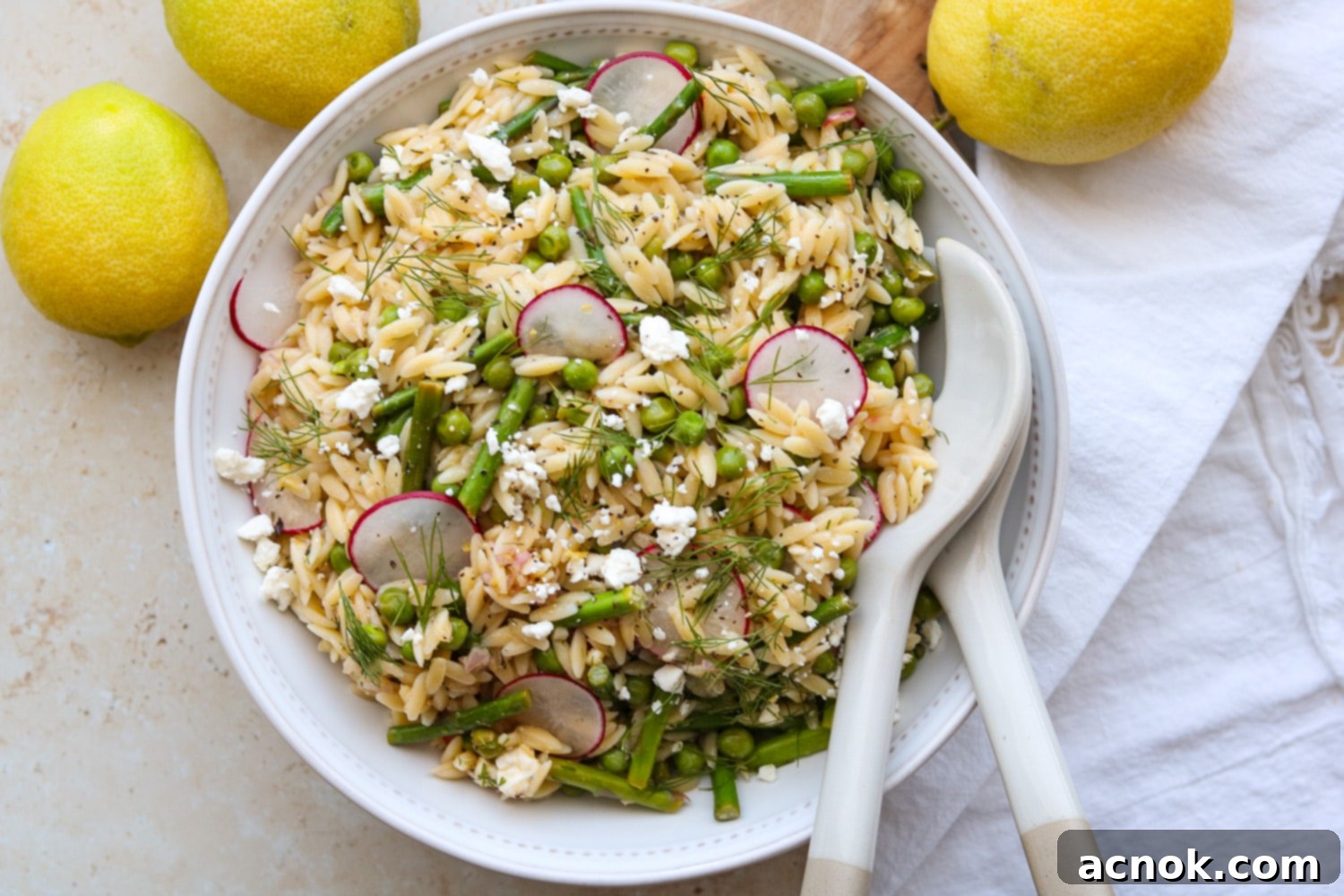Light & Lemony Spring Orzo Salad with Asparagus and Peas: Your Go-To Easy Recipe
Embrace the vibrant flavors of spring with this incredibly easy and refreshingly delicious Orzo Salad featuring tender asparagus and sweet peas. This delightful dish perfectly captures the essence of the season, making it an ideal choice for quick weeknight dinners, lively brunches, or a delightful addition to any BBQ spread. Orzo, a versatile rice-shaped pasta, serves as the perfect base, expertly soaking up a bright and zesty dressing made with an abundance of fresh lemon juice, fragrant lemon zest, a hint of aromatic garlic, and fresh dill. Complemented by the subtle tang of crumbled Feta cheese, or even a vegan alternative for a plant-based option, this salad promises a harmonious blend of textures and tastes that will delight your palate. We’ll guide you through making this simple yet elegant salad, offering essential tips for achieving perfectly al dente pasta, infusing maximum flavor into your add-ins, and how to effortlessly customize it to suit your preferences.
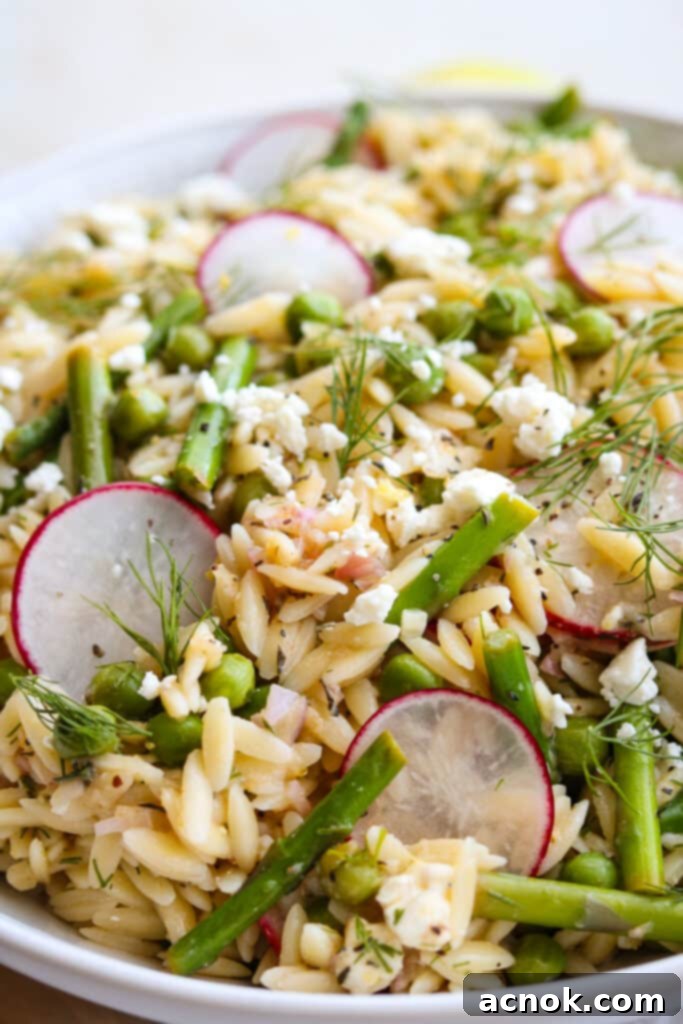
Table of Contents
- What is Orzo? Understanding This Versatile Pasta
- Why is Orzo So Popular?
- General Guideline on How to Cook Orzo
- How to Prepare This Refreshing Orzo Salad
- Ingredients for a Burst of Spring Flavor
- Step-by-Step Directions for a Perfect Orzo Salad
- How to Assemble and Serve Your Flavorful Orzo Salad
- Frequently Asked Questions about Orzo & Substitutions
What is Orzo? Understanding This Versatile Pasta Shape
Orzo, also widely recognized as Risoni, is a unique and captivating small, rice-shaped pasta that originates from the heart of Italy. There, it is traditionally categorized under the charming umbrella term of pastina, which encompasses a variety of tiny pasta shapes frequently used to add substance and comfort to broths and soups. Despite its striking resemblance to grains of rice, an appearance that often leads to confusion, Orzo is undeniably a pasta. It is typically crafted from high-quality durum wheat semolina, but you can also find variations made from whole wheat or white flour, each offering a slightly different texture and nutritional profile. Its diminutive size, combined with its remarkably quick cooking time, renders it incredibly versatile and a cherished ingredient among cooks. Beyond traditional soups, Orzo finds its way into an array of dishes, including flavorful pilafs, comforting casseroles, vibrant hot and cold salads, and even as a delightful, lighter alternative to rice in creamy risottos. The true culinary magic of Orzo lies in its exceptional ability to absorb flavors beautifully, making it an outstanding canvas for rich sauces, herbaceous dressings, and, as you’ll experience in this spring salad recipe, a medley of fresh ingredients.
While Orzo is predominantly made with wheat, it’s a very common misconception that it is inherently gluten-free. It is not, as it contains wheat. However, the good news for those with dietary restrictions is that the market now offers an impressive selection of high-quality gluten-free varieties. Brands like DeLallo provide excellent gluten-free Orzo options, ensuring that everyone, regardless of their gluten sensitivity, can enjoy this beloved pasta shape. Its popularity has transcended Italian borders, establishing a cherished presence in the rich and diverse cuisines of many Mediterranean countries, where it is ingeniously adapted into countless regional specialties, demonstrating its global culinary appeal.
Why is Orzo So Popular? Its Culinary Advantages Explained
Orzo’s widespread appeal and consistent presence in kitchens around the world stem from a compelling combination of attributes that make it a firm favorite for both seasoned professional chefs and enthusiastic home cooks alike. Paramount among these is its remarkable versatility. Orzo is available in a spectrum of forms—ranging from readily available gluten-free options and nutrient-rich cassava-based varieties to wholesome whole wheat and visually appealing tri-color pasta—ensuring it adapts effortlessly to diverse dietary needs and an endless array of culinary creations. Its elegantly neutral flavor profile means it can either command attention as the star of a dish or humbly serve as a subtle, yet crucial, complement, gracefully absorbing the robust flavors of a hearty, slow-cooked sauce or the delicate, bright notes of a light vinaigrette.
Another significant advantage that contributes to its popularity is its rapid cooking nature. Typically prepared to al dente perfection in a mere 7 to 10 minutes, Orzo is an absolute godsend for busy weeknights when a delicious and nutritious meal needs to be on the table without delay. This swift preparation, coupled with its robust ability to maintain its pleasing texture in both hot and cold applications, positions it as an ideal choice for everything from comforting, oven-baked dishes to refreshing, chilled pasta salads. Its small, grain-like shape also makes it remarkably easy to eat, rendering it a universally family-friendly option that even the pickiest eaters often enjoy. This particular Spring Orzo Salad is a shining testament to Orzo’s flexibility, proving equally delightful whether served chilled or at a comfortable room temperature, making it a fantastic and adaptable companion to a wide variety of main courses. Consider serving it alongside a succulent Simple Roasted Chicken, your favorite flaky grilled fish, or a flavorful Two-Ingredient Tri Tip. For those seeking a complete and satisfying vegetarian experience, pairing this Orzo salad with a crisp Butter Lettuce Green Salad creates a light, balanced, and truly satisfying meal.
General Guideline on How to Cook Orzo for Perfect Results
Achieving perfectly cooked Orzo is a fundamental step to the success of any dish it graces, particularly a pasta salad where the texture of each ingredient plays a pivotal role. Generally, this small, rice-shaped pasta cooks quite rapidly, typically reaching that ideal firm-tender, or al dente, consistency in approximately 7 to 10 minutes. However, it is always paramount to refer to the specific package directions of your chosen Orzo, as cooking times can vary subtly by brand and type—for instance, gluten-free or whole wheat varieties might require a minute or two longer to cook properly.
For cold pasta dishes, such as our vibrant Spring Orzo Salad, the correct post-cooking procedure is crucial. After cooking the Orzo to a perfect al dente, you must immediately rinse it under cold running water. This rinsing step serves two critical purposes: first, it effectively halts the cooking process, preventing the pasta from becoming overcooked and mushy, which is undesirable in a salad. Second, it washes away any excess starch from the pasta’s surface, a key action that helps prevent the individual grains from clumping and sticking together as they cool, ensuring a light and separate texture. Conversely, for hot dishes where Orzo is intended to be incorporated into a sauce, it is generally best to *not* rinse the pasta. In this scenario, the starchy coating that remains on the Orzo actually serves a beneficial purpose: it helps to naturally thicken the sauce and allows it to cling more effectively to the pasta, contributing to a more cohesive, rich, and flavorful final product. Regardless of whether you’re making a hot or cold dish, always ensure you cook Orzo in a large pot with ample, generously salted water. This provides sufficient room for the pasta to cook evenly and allows it to absorb a subtle, foundational seasoning from within, enhancing its natural flavor.
How to Prepare This Refreshing Spring Orzo Salad
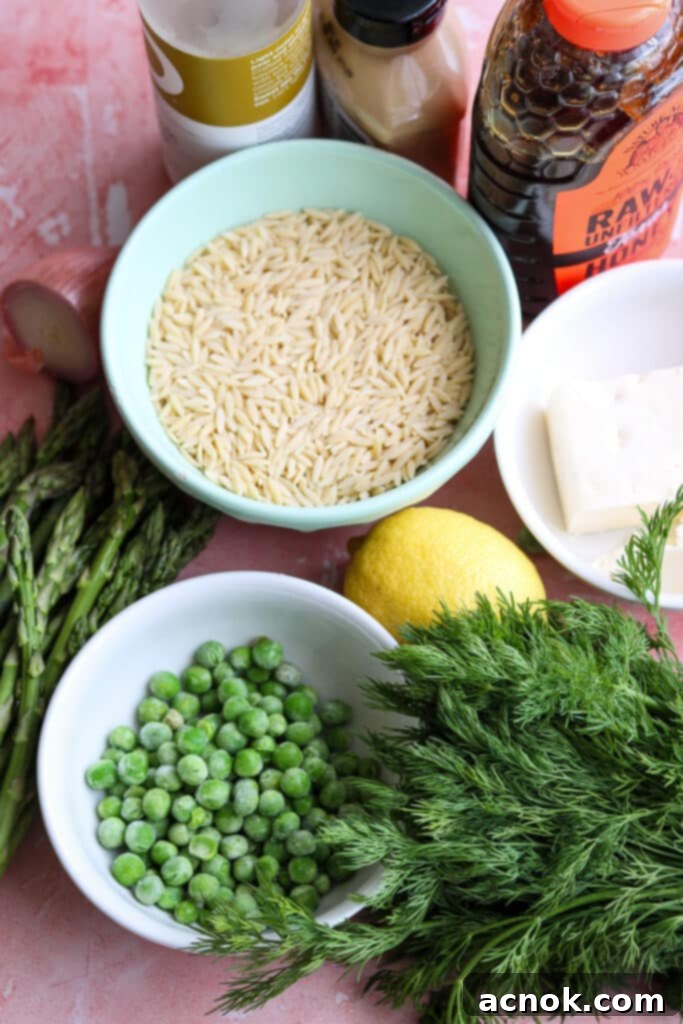
Ingredients for a Burst of Spring Flavor
- 1 1/2 cups of Orzo pasta: The foundational element of our salad, quick-cooking and perfect for soaking up all the delicious dressing flavors.
- 1/2 bunch of Asparagus: Freshly washed, thoroughly dried, with the tough woody ends snapped off, and then chopped into appealing 2-inch pieces. These vibrant green spears are quintessential spring vegetables, adding a delightful crisp-tender texture and subtle earthy notes.
- 1 cup of fresh or frozen peas: Sweet, tender, and beautifully bright green, peas are a classic spring vegetable that pop with flavor and add a wonderful burst of color to the salad.
- 2 tablespoons of fresh dill leaves, chopped: Plus a little more for a final garnish. Fresh dill is key, bringing a wonderfully aromatic, slightly anise-like, and distinctly herbaceous note that elevates the entire dressing and salad profile.
- 1/4 cup lemon juice: Freshly squeezed is non-negotiable for this recipe, providing that essential bright, tangy, and zesty flavor that defines a refreshing spring salad.
- 1 teaspoon of lemon zest: Do not underestimate the power of lemon zest! It significantly intensifies the lemony aroma and taste, adding a vibrant, essential depth that fresh juice alone cannot provide.
- 1 tablespoon white balsamic vinegar: A milder and subtly sweeter vinegar compared to dark balsamic, it complements the lemon beautifully without overpowering the delicate spring flavors. As a flexible alternative, high-quality apple cider vinegar can also be a good substitute.
- 2 cloves of garlic, minced: Adds a pungent, aromatic kick and a foundational layer of savory flavor to our vibrant dressing.
- 2 tablespoons of shallot, finely chopped: Milder and more delicate than a standard onion, finely chopped shallots offer a nuanced, sweet-savory base that beautifully rounds out the dressing without harshness.
- 1/2 teaspoon honey or agave syrup: A small touch of natural sweetness is crucial for balancing the acidity from the lemon and vinegar, creating a perfectly harmonious dressing.
- 1 teaspoon Dijon mustard: Beyond its tangy and slightly spicy flavor, Dijon mustard plays a vital role as an emulsifier, helping to bind the oil and vinegar together for a smooth, cohesive dressing.
- 1 teaspoon of dried Thyme: Earthy, savory, and aromatic, dried thyme pairs exquisitely with lemon and the fresh flavors of spring vegetables, adding a classic herbal depth.
- 1/2 tsp of Paprika, sweet: Not just for color, sweet paprika adds a mild, smoky depth and a beautiful, warm hue to the dressing, enhancing its visual appeal.
- 1 teaspoon Kosher salt (I use Morton’s): Plus a generous large pinch for the pasta cooking water. Salt is absolutely essential for seasoning both the pasta itself from within and for bringing out all the vibrant flavors in the final salad.
- 1/2 teaspoon ground pepper: Freshly ground black pepper is recommended for its sharp, aromatic finish, providing a gentle kick that complements the other ingredients.
- 2-3 Radishes, thinly sliced: These add a delightful, crisp texture and a distinct peppery bite, along with beautiful pops of red color, both within the salad and as an attractive garnish.
- 1/4-1/2 cup Feta cheese, crumbled or cubed: This ingredient is optional but highly recommended for its salty, tangy, and creamy characteristics that wonderfully complement the fresh vegetables and bright dressing. For a completely vegan version, simply omit the Feta or use a high-quality plant-based feta alternative.
Step-by-Step Directions for a Perfect Orzo Salad
Follow these clear and simple steps to create a vibrant and flavorful Orzo salad that’s sure to impress with its fresh taste and appealing texture.
- Cook the Orzo and Vegetables: Begin by adding 4 quarts of fresh water to a large, heavy-bottomed pot. Season the water generously with a large pinch of kosher salt – this crucial step seasons the pasta from within and enhances its flavor – then bring it to a vigorous rolling boil over high heat. Once the water is boiling, add the 1 1/2 cups of Orzo pasta. Cook the Orzo for 5 minutes to give it a head start and ensure even cooking. After 5 minutes, introduce the prepared fresh asparagus (chopped into 2-inch pieces) and the fresh or frozen peas directly into the same pot with the pasta. Continue to cook for an additional 2 minutes.
- Check for Doneness and Drain: At the end of the cooking time, check the pasta for doneness: it should be firm to the bite but tender throughout (al dente). The asparagus should be crisp-cooked, retaining a slight bite, and the peas should be cooked through but still firm and vibrant green. IMPORTANT NOTE: If you are using a different type of Orzo (e.g., gluten-free, whole wheat, or a brand with slightly varying cooking times), always consult the package instructions. The key is to add the vegetables approximately 2 minutes before the pasta’s total recommended cooking time is complete to ensure they are perfectly cooked and not overdone.
- Rinse and Cool: Immediately drain the cooked pasta and vegetables together in a colander. Rinse them thoroughly under cold running water until they are completely cool to the touch. This step is absolutely vital for a cold pasta salad as it effectively stops the cooking process and prevents the Orzo from clumping and becoming sticky. Drain exceptionally well to ensure no excess water remains, then transfer the cooled Orzo and vegetables to a spacious medium-sized mixing bowl.
- Prepare Fresh Herbs and Garnish: While the pasta mixture cools, finely chop 2 tablespoons of fresh dill leaves, focusing on the tender fronds and discarding any tough, larger stems for a cleaner texture. Set the chopped dill aside. Thinly slice the radishes, preparing enough for both inclusion in the salad and as a colorful, peppery garnish. Set these aside as well.
- Prepare the Feta: If you are using a block of Feta cheese, chop it into small, even cubes for consistent texture throughout the salad. If you have pre-crumbled Feta, it’s ready to incorporate.
- Whisk the Dressing Ingredients: For the bright and zesty lemon herb dressing, gather a small jar with a tight-fitting lid or a small mixing bowl. Add the fresh lemon juice, potent lemon zest, white balsamic vinegar (or your chosen substitute), minced garlic, finely chopped shallot, a touch of honey (or agave syrup), Dijon mustard, dried thyme, sweet paprika, kosher salt, and ground pepper.
- Emulsify the Dressing: Slowly whisk the extra virgin olive oil into the mixture, adding it in a thin, steady stream while continuously whisking vigorously. Continue this process until the dressing comes together and emulsifies into a smooth, cohesive, and slightly thickened sauce. This careful emulsification ensures all the vibrant flavors are beautifully blended and distributed.
- Alternative Dressing Method: As an even easier alternative, you can place all the dressing ingredients into a jar, secure the lid tightly, and shake vigorously for about 30-60 seconds until completely emulsified and thoroughly combined.
How to Assemble and Serve Your Flavorful Orzo Salad
Now that all your components are perfectly prepared, it’s time to bring this delicious spring salad together. The assembly is straightforward, offering opportunities for customization to ensure it meets your exact taste preferences.
- Combine and Toss: In the medium-sized bowl containing your cooled Orzo, asparagus, and peas, add approximately half of the prepared lemony herb dressing. Next, incorporate the chopped fresh dill, the thinly sliced radishes, and the crumbled or cubed Feta cheese (if you are including it). Gently toss all the ingredients together using large spoons or tongs until everything is evenly coated with the vibrant dressing.
- Taste and Adjust: Take a moment to taste a spoonful of the salad. This is your crucial opportunity to adjust the seasoning to perfection. You might find it needs a little more salt, an extra grind of pepper, or additional dressing to reach your desired level of flavor intensity and moisture. (NOTE: While I typically find myself using all of the dressing for this recipe, starting with half allows you the flexibility to customize the intensity to your liking, ensuring the salad is never overdressed or lacking in flavor.)
- Chill for Flavor Development: Once seasoned to your satisfaction, cover the bowl tightly with plastic wrap or a lid and refrigerate the Orzo salad for at least 30 minutes. This chilling period is not merely to cool the salad; it’s a vital step that allows all the distinct flavors to meld, deepen, and truly harmonize, resulting in a more integrated and utterly delicious taste experience.
- Garnish and Serve: Before presenting and serving your beautiful salad, give it another gentle toss to redistribute any settled dressing. Garnish generously with any reserved thinly sliced radishes and extra fresh dill leaves for a stunning visual presentation and a final burst of fresh flavor. Enjoy this bright, lemony Orzo Pasta salad with Asparagus and Peas as a refreshing and satisfying side dish or a light, delightful main course!
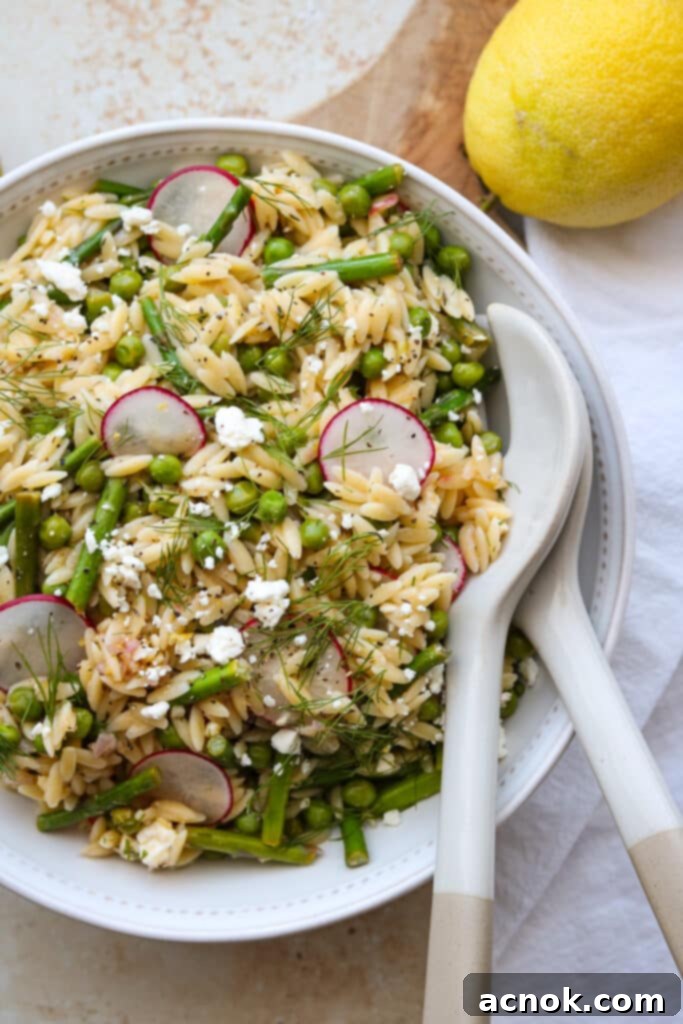
We truly hope you enjoy preparing and savoring this delightful, lemony Orzo Pasta salad with Asparagus and Peas! We are always eager to hear about your culinary adventures and any creative variations you might discover. Please feel free to share your thoughts, tips, and experiences in the comments section below! Your feedback helps other readers and truly brightens our day. And if you’re craving another fantastic Orzo recipe that’s bursting with seasonal goodness, be sure to try our Summer Pesto Orzo Pasta Salad, which is brimming with the vibrant flavors of summer.
Frequently Asked Questions About Orzo & Substitutions
A standard 1lb (or approximately 450g) package of dry Orzo pasta is quite versatile in terms of yield. When prepared as a standalone main dish, it typically yields about 8 generous servings, providing a satisfying portion for each person. If it’s served as a side dish, especially when thoughtfully combined with other flavorful ingredients as in a pasta salad like this one, it can easily stretch to between 12 and 16 servings, depending largely on the volume of the additional ingredients and the specific portion sizes served.
For those prioritizing nutritional value, the whole wheat version of Orzo is generally considered the healthiest choice. When compared to Orzo made from refined white flour or semolina, whole wheat Orzo offers a significantly higher fiber content. This increased fiber is beneficial for digestive health, helps regulate blood sugar levels, and contributes to a greater feeling of fullness and satiety. While calorie and fat content are usually quite similar across different Orzo types, the boosted fiber and complex carbohydrates in whole wheat make it a more nutritious option for sustained energy and overall well-being.
No, Orzo is distinctly not the same as Risotto. Authentic Italian risotto is a classic creamy rice dish that is traditionally crafted with specific short-grain rice varieties, most commonly Arborio or Carnaroli rice. These particular rice types are prized for their high starch content and their unique ability to slowly absorb liquid while cooking, yielding the characteristic rich, creamy texture of a true risotto. Orzo, conversely, is a type of pasta, made from either whole wheat, semolina, or white flour. While its small size and versatility do allow it to be used to create a “risotto-style” dish with a similar texture, it will never precisely replicate the deep, creamy consistency or the nuanced flavor profile of a traditional rice-based risotto.
Absolutely! This Orzo salad recipe is remarkably adaptable, and you can easily substitute other vegetables for asparagus to suit your taste or what’s seasonally available. Fresh green beans are an excellent substitute and can be prepared following the exact same directions—simply add them to the pasta water a couple of minutes before the Orzo is done cooking. Other fantastic options include blanched broccoli florets for a heartier texture, sweet sugar snap peas for extra crunch, or even finely diced bell peppers (which can be added raw for a crisp bite or lightly sautéed for a softer texture).
If Orzo pasta isn’t readily available or you’re simply in the mood for a different texture, you have several excellent pasta alternatives that will work wonderfully in this recipe. Small pasta shapes like Ditalini or small shell pasta are great choices, as they offer a similar bite and possess ample nooks and crannies to hold the delicious dressing. For a unique, slightly nutty, and hearty twist, consider using Farro. If you opt for Farro, remember that its cooking time is different from Orzo; simply cook it according to its package directions separately. You would also need to blanch the asparagus and peas separately before combining them with the cooked Farro and the vibrant dressing.
Yes, this Spring Orzo Salad is an absolutely perfect candidate for your weekly meal prep! Its flavors have a wonderful tendency to develop and deepen as it sits, making it even more delicious on subsequent days. For optimal freshness and to prevent any potential sogginess, we highly recommend storing the prepared salad components and the dressing in separate airtight containers in the refrigerator. When you’re ready to enjoy a serving, simply add the desired amount of dressing, give it a good toss, and top with crumbled Feta and perhaps some lean grilled chicken or salmon for a satisfying, complete meal that’s ready in minutes.
Certainly! If white balsamic vinegar isn’t on hand in your pantry, you have excellent substitutes that will work beautifully in this recipe. Both white wine vinegar and apple cider vinegar are fantastic alternatives. White wine vinegar offers a crisp, clean acidity that will complement the lemon and herbs wonderfully, while apple cider vinegar provides a slightly fruitier and tangier note. Choose the one that best suits your personal taste preference or simply use what you have readily available for a delicious result.
If you tried this delightful recipe, please help other readers by commenting below and sharing some stars! We 🫶🏼 appreciate you and your support!
All content and photographs ©Claudia’s Table and claudiastable.com
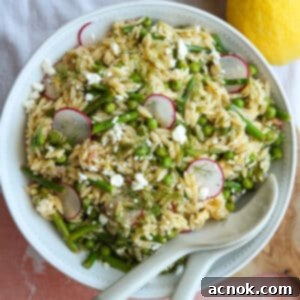
Orzo Salad with Asparagus and Peas
Ana | Claudia’s Table
July 21, 2023
Pin Recipe
Equipment
-
1 bowl medium, ideal for mixing and chilling the salad
-
1 pot 5 qt, for cooking orzo and vegetables efficiently
-
1 microblade for zesting lemon (optional, but highly recommended for the best lemony aroma and flavor)
Ingredients
Salad
- 1 1/2 cups Orzo pasta dried, forming the delightful, versatile base of our salad
- 1/2 bunch Asparagus, fresh Washed, dried, tough ends removed, and chopped into 2-inch pieces for a crisp-tender, seasonal bite
- 1 cup peas fresh or frozen, adding sweet pops of color and delicate flavor
- 2 tablespoons dill fresh, leaves only, chopped + more for garnish, for a bright, herbaceous, and aromatic note
- 3 whole radish thinly sliced for both the salad and a vibrant garnish, offering a crisp texture and peppery kick
- 1/4-1/2 cup Feta cheese crumbled or cubed (optional), for a delightful salty, tangy creaminess that enhances the other flavors
Dressing
- 1/4 cup lemon juice fresh squeezed, for that essential burst of bright, zesty flavor
- 1 teaspoon lemon zest vital for intensifying the lemony aroma and adding complex citrus notes
- 1 tablespoon White Balsamic Vinegar or Apple cider vinegar, contributing a mild, sweet tang that balances the dressing
- 2 cloves garlic minced, for aromatic depth and a subtle pungent kick
- 2 tablespoons shallot finely chopped, providing a delicate onion flavor that’s milder than traditional onions
- 1/2 teaspoon honey or agave syrup, essential for balancing the acidity of the lemon and vinegar
- 1 teaspoon Dijon mustard acts as an emulsifier for the dressing and adds a subtle tangy kick
- 1 teaspoon thyme dried, contributing earthy, aromatic undertones that pair beautifully with lemon
- 1/2 teaspoon paprika sweet, for a mild, pleasant flavor and a lovely hint of color in the dressing
- 1 teaspoon Kosher salt (Morton’s)+ a large pinch for pasta cooking water, essential for proper seasoning throughout the dish
- 1/2 teaspoon ground pepper freshly ground, for a sharp, aromatic finish that complements the fresh flavors
- 1/8 cup olive oil extra virgin, forming the rich, binding agent for our harmonious dressing
Instructions
Preparing the Pasta and Vegetables
-
To begin, add 4 quarts of fresh water to a large, heavy-bottomed pot. Season the water generously with a large pinch of kosher salt – this crucial step seasons the pasta from within and enhances its flavor – then bring it to a vigorous rolling boil over high heat.
-
Once the water is boiling, add the 1 1/2 cups of Orzo pasta. Cook the Orzo for 5 minutes to give it a head start and ensure even cooking. After 5 minutes, introduce the prepared fresh asparagus (chopped into 2-inch pieces) and the fresh or frozen peas directly into the same pot with the pasta. Continue to cook for an additional 2 minutes.
-
At the end of the cooking time, check the pasta for doneness: it should be firm to the bite but tender throughout (al dente). The asparagus should be crisp-cooked, retaining a slight bite, and the peas should be cooked through but still firm and vibrant green.
-
IMPORTANT NOTE: If you are using a different type of Orzo (e.g., gluten-free, whole wheat, or a brand with slightly varying cooking times), always consult the package instructions. The key is to add the vegetables approximately 2 minutes before the pasta’s total recommended cooking time is complete to ensure they are perfectly cooked and not overdone.
-
Immediately drain the cooked pasta and vegetables together in a colander. Rinse them thoroughly under cold running water until they are completely cool to the touch. This step is absolutely vital for a cold pasta salad as it effectively stops the cooking process and prevents the Orzo from clumping and becoming sticky. Drain exceptionally well to ensure no excess water remains, then transfer the cooled Orzo and vegetables to a spacious medium-sized mixing bowl.
-
Next, finely chop 2 tablespoons of fresh dill leaves, focusing on the tender fronds and discarding any tough, larger stems for a cleaner texture. Set the chopped dill aside.
-
Thinly slice the radishes, preparing enough for both inclusion in the salad and as a colorful, peppery garnish. Set these aside as well.
-
If you are using a block of Feta cheese, chop it into small, even cubes for consistent texture throughout the salad. If you have pre-crumbled Feta, it’s ready to incorporate.
Preparing the Lemony Herb Dressing
-
For the bright and zesty lemon herb dressing, gather a small jar with a tight-fitting lid or a small mixing bowl. Add the fresh lemon juice, potent lemon zest, white balsamic vinegar (or your chosen substitute), minced garlic, finely chopped shallot, a touch of honey (or agave syrup), Dijon mustard, dried thyme, sweet paprika, kosher salt, and ground pepper.
-
Slowly whisk the extra virgin olive oil into the mixture, adding it in a thin, steady stream while continuously whisking vigorously. Continue this process until the dressing comes together and emulsifies into a smooth, cohesive, and slightly thickened sauce. This careful emulsification ensures all the vibrant flavors are beautifully blended and distributed.
-
As an even easier alternative, you can place all the dressing ingredients into a jar, secure the lid tightly, and shake vigorously for about 30-60 seconds until completely emulsified and thoroughly combined.
Assembling and Chilling the Salad
-
In the bowl with your cooled Orzo, asparagus, and peas, add approximately half of the prepared lemony herb dressing. Next, incorporate the chopped fresh dill, the thinly sliced radishes, and the crumbled or cubed Feta cheese (if you are including it). Gently toss all the ingredients together using large spoons or tongs until they are evenly coated with the vibrant dressing. Taste the salad for seasoning – you may want to add more salt, pepper, or additional dressing to achieve your preferred flavor balance and moisture level. NOTE: While I often find myself using all of the dressing for this recipe, starting with half allows you the flexibility to customize the intensity to your liking, ensuring the salad is never overdressed or lacking in flavor.
-
Once seasoned to your satisfaction, cover the bowl tightly with plastic wrap or a lid and chill the Orzo salad in the refrigerator for at least 30 minutes. This chilling period is not merely to cool the salad; it’s a vital step that allows all the distinct flavors to meld, deepen, and truly harmonize, resulting in a more integrated and utterly delicious taste experience.
-
Before presenting and serving your beautiful salad, give it a final gentle toss to redistribute any settled dressing. Garnish generously with any reserved thinly sliced radishes and extra fresh dill leaves for a stunning visual presentation and a final burst of fresh flavor. Serve chilled or at room temperature as a vibrant side dish or a light, refreshing main meal. Enjoy!
Notes
Nutrition
Nutritional information is calculated online and should be used as a guide. Individual results may vary.
All content and photographs ©Claudia’s Table and claudiastable.com
Check out our New & Delicious Posts Below
- Pasta with Grilled Vegetables, Feta, and Lemon
- Grilled Asian Marinated Flank Steak
- Classic Homemade Chunky Blue Cheese Dressing
- 3-Ingredient Crispy Oven-Roasted Potatoes
- Grilled Peach Avocado Chicken Salad
